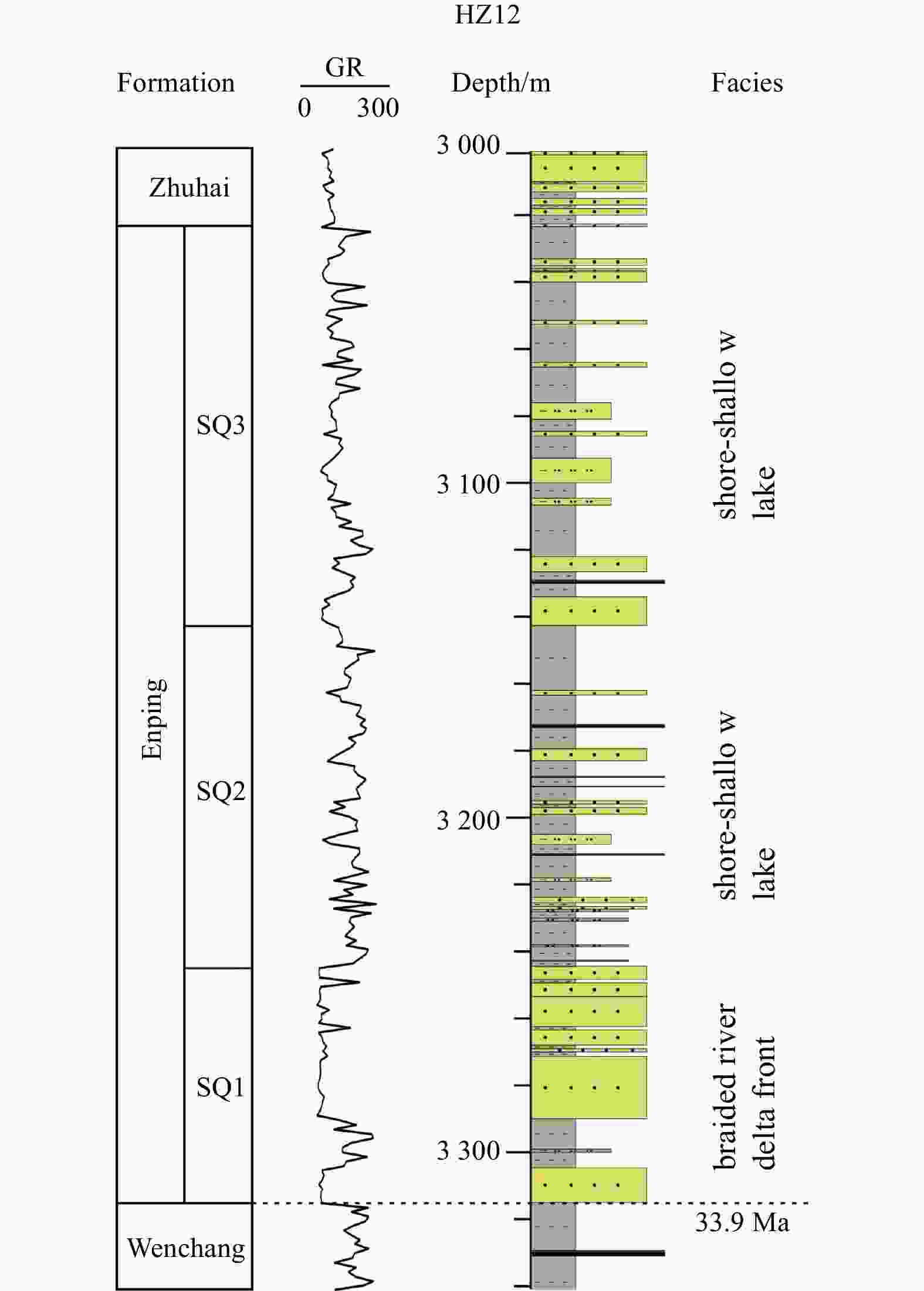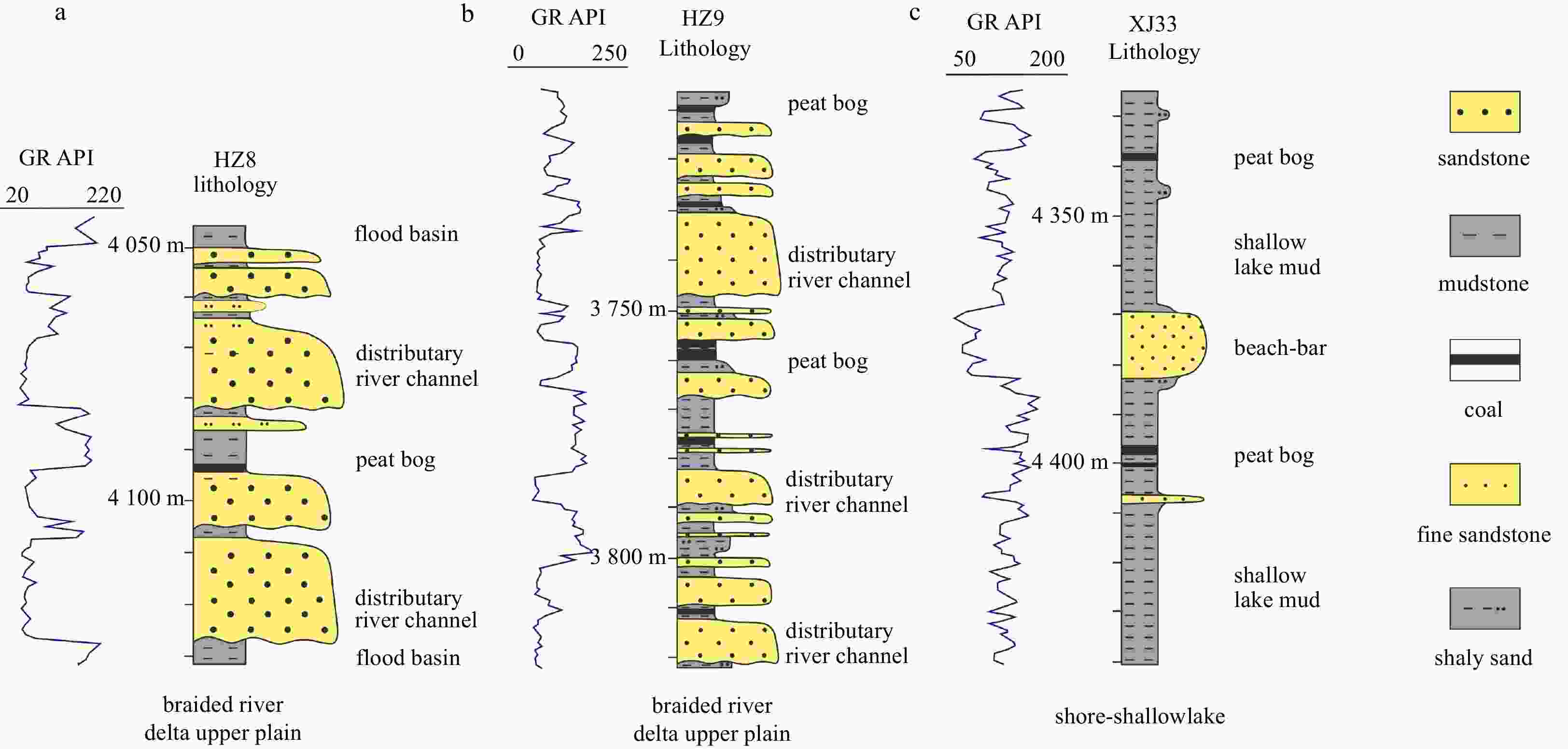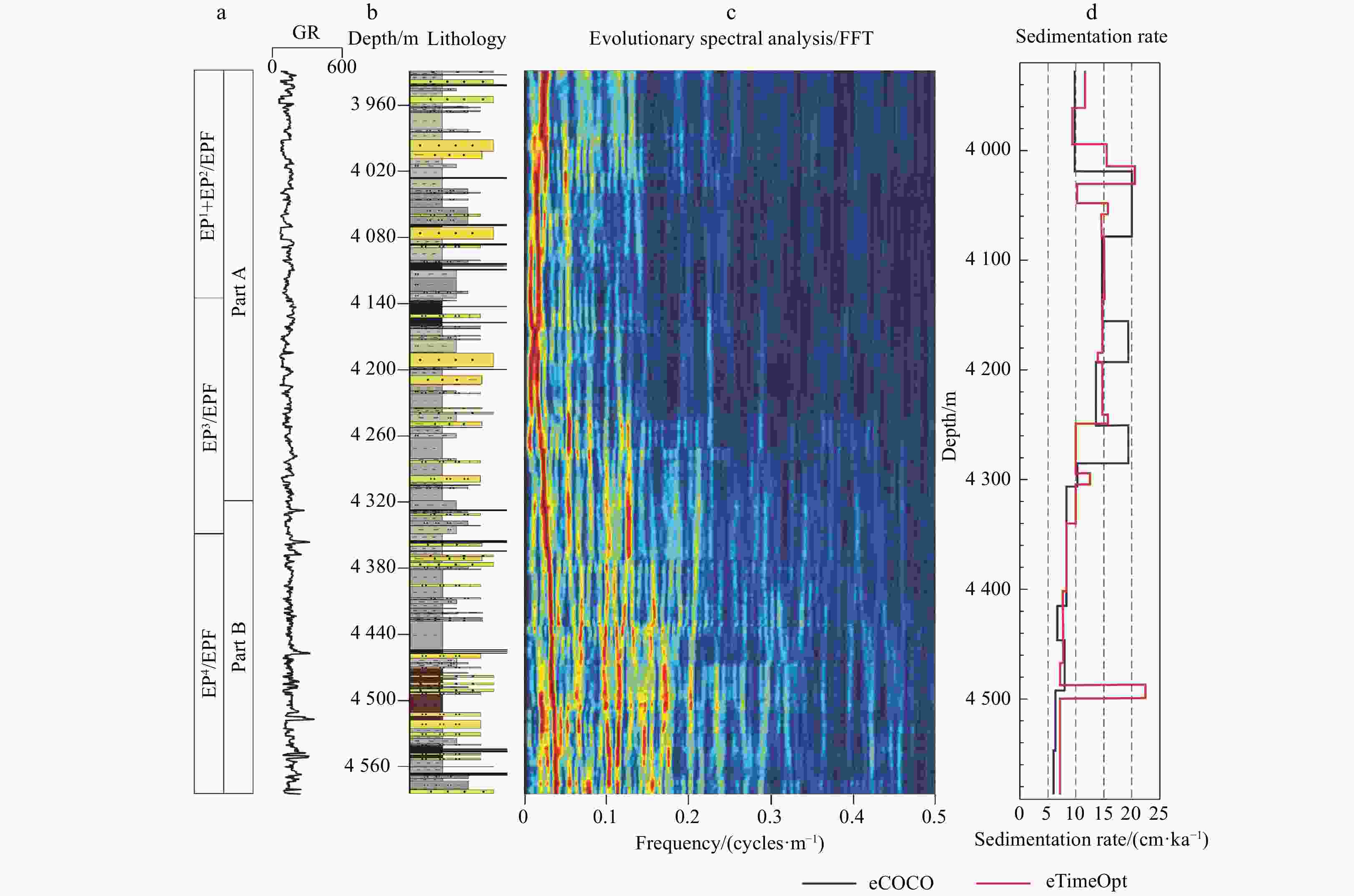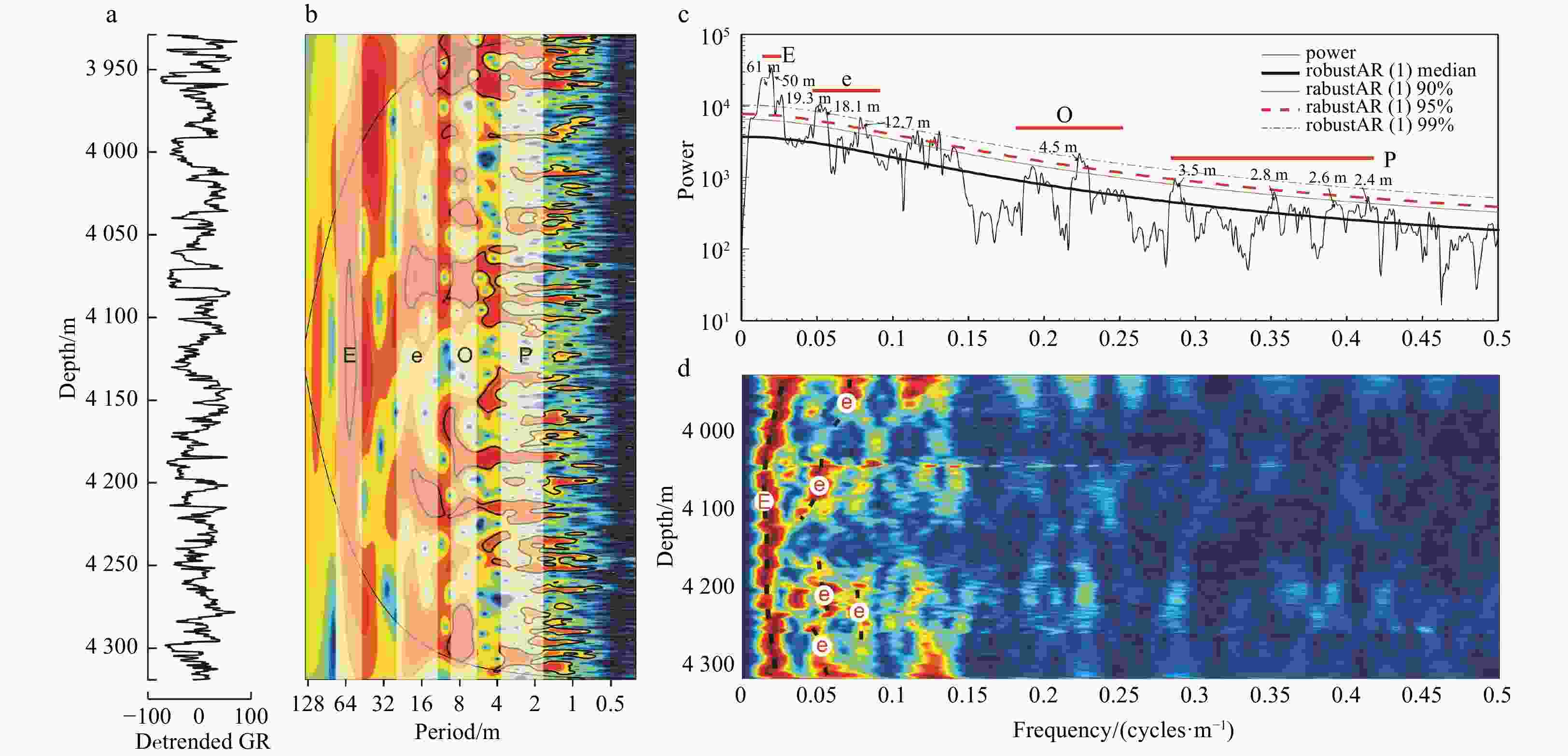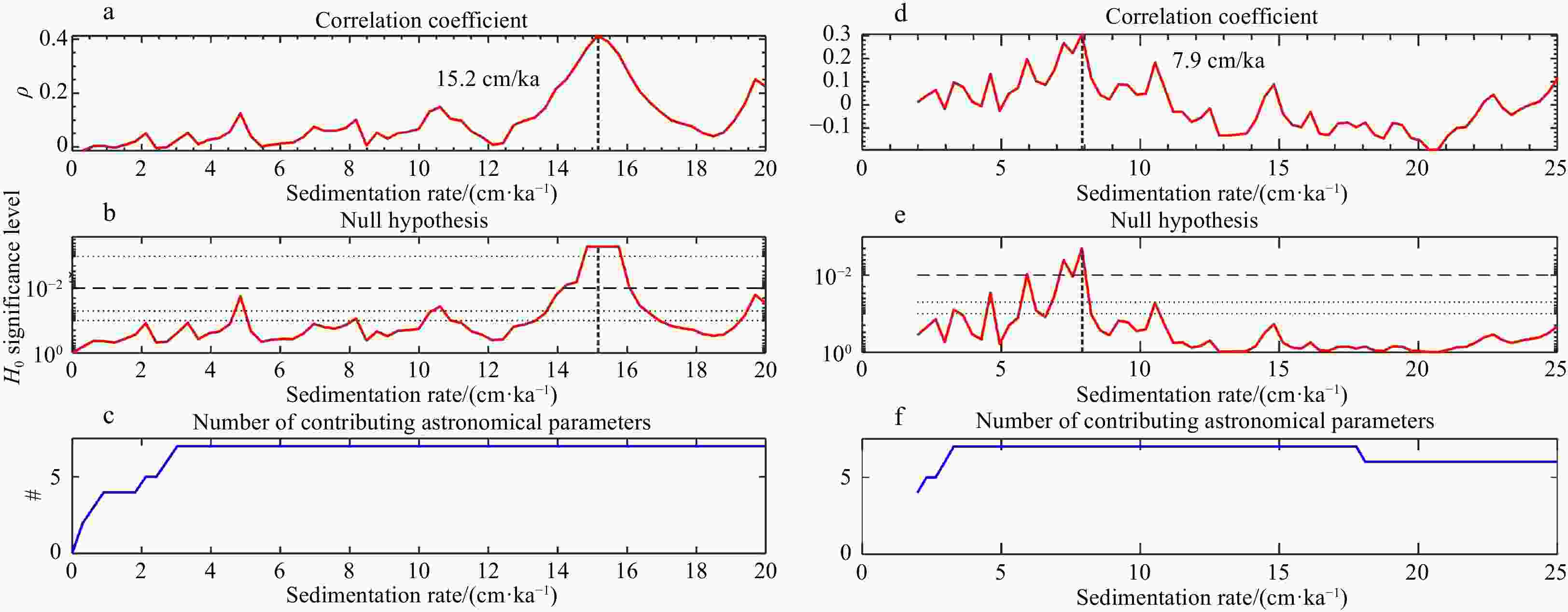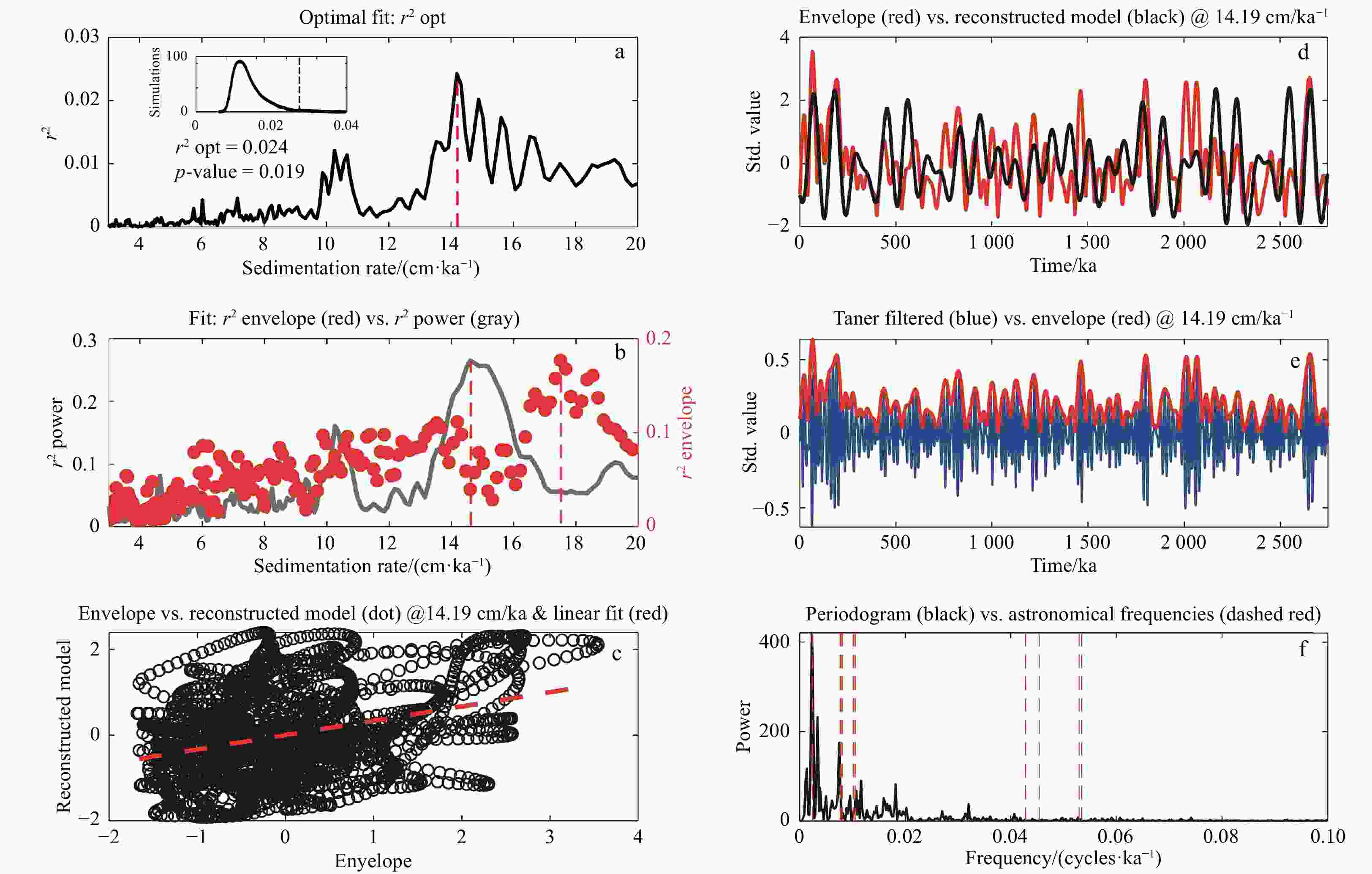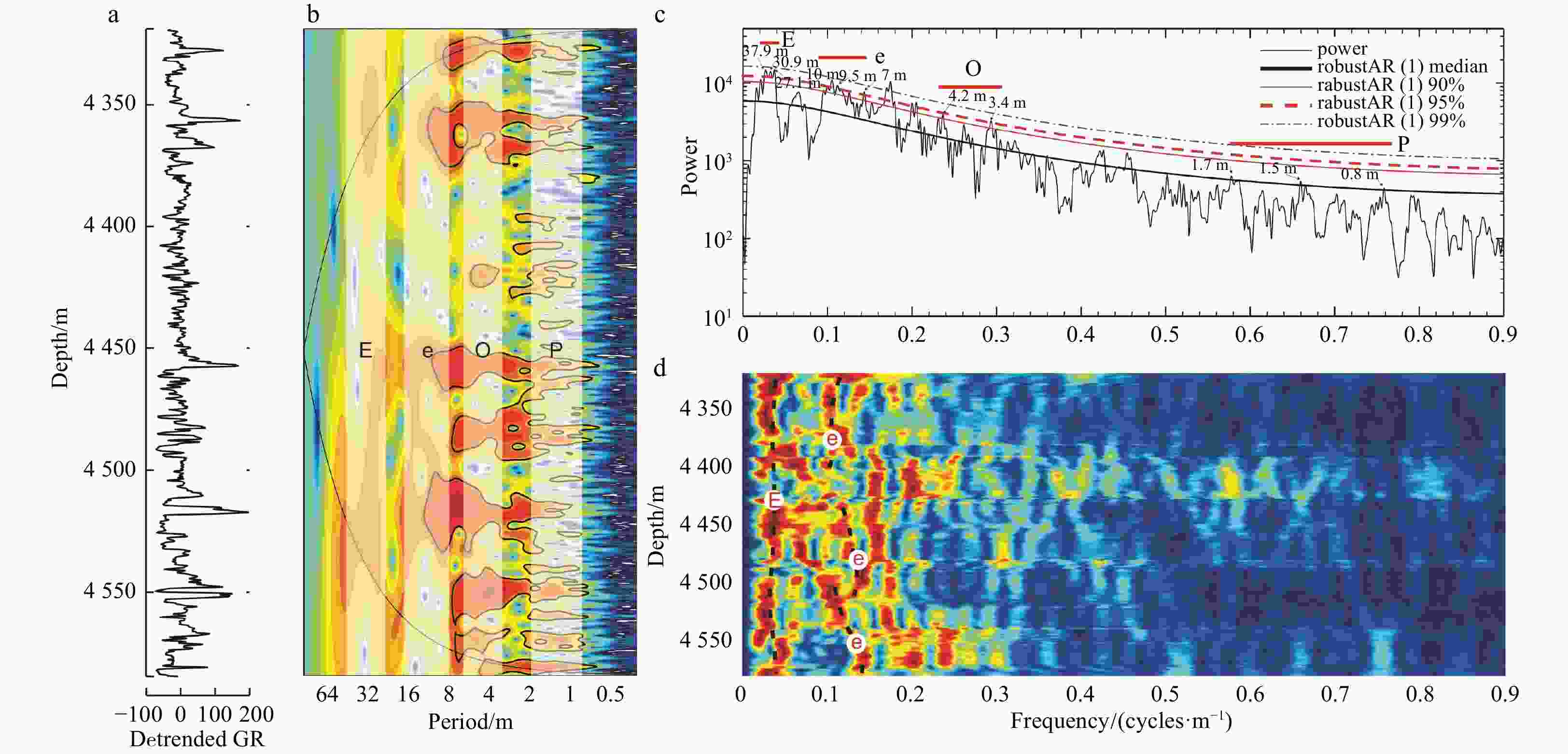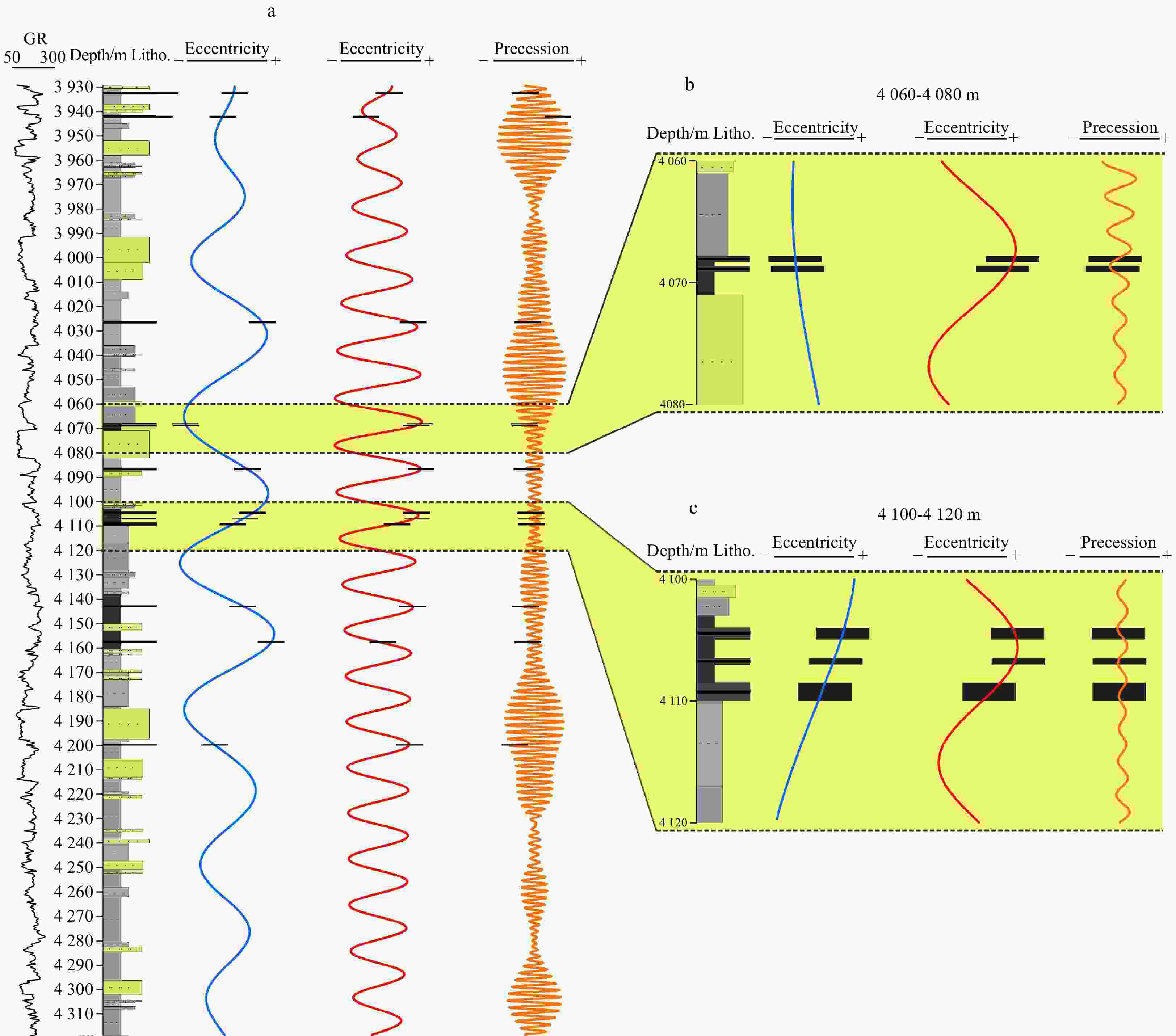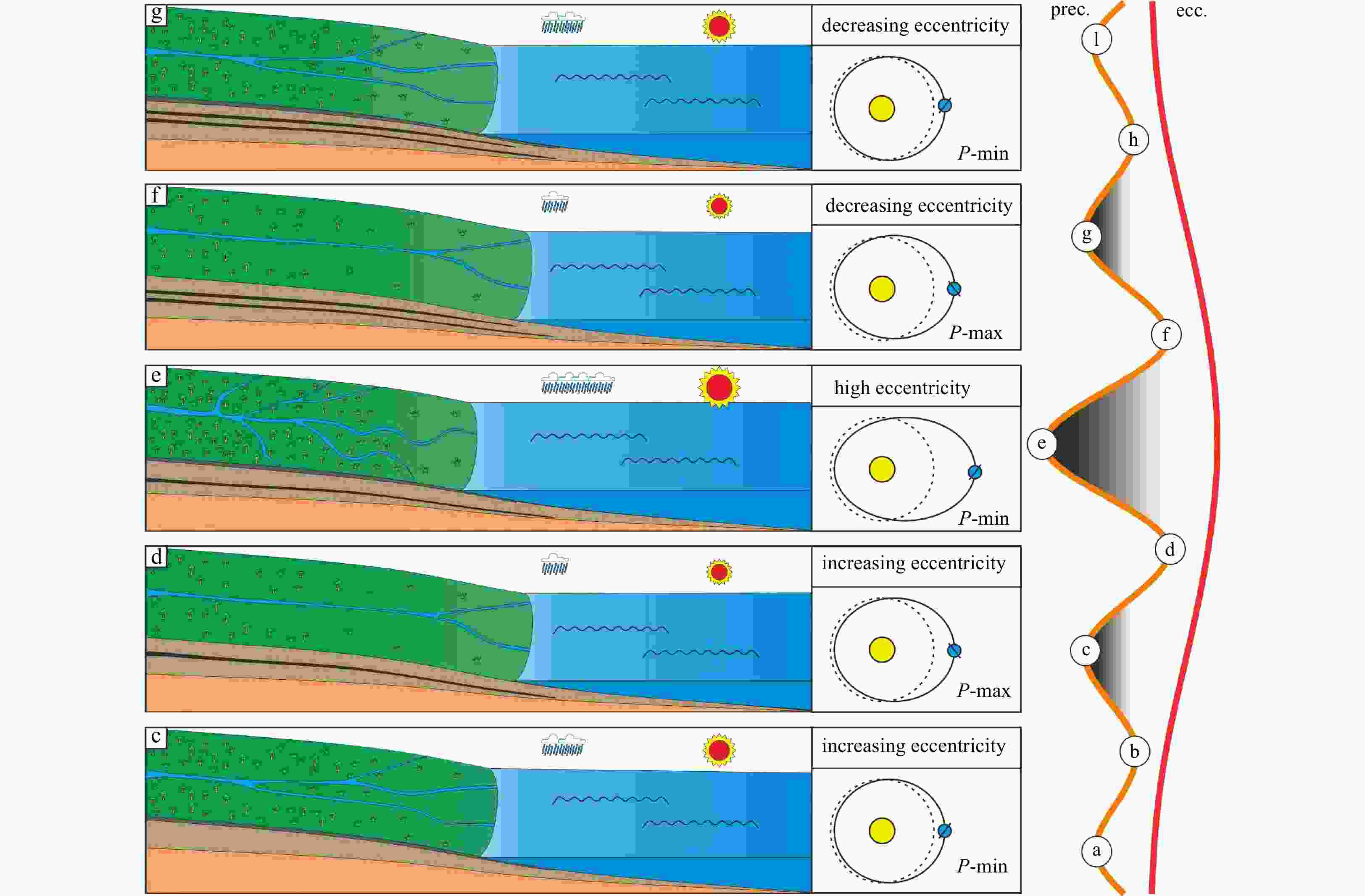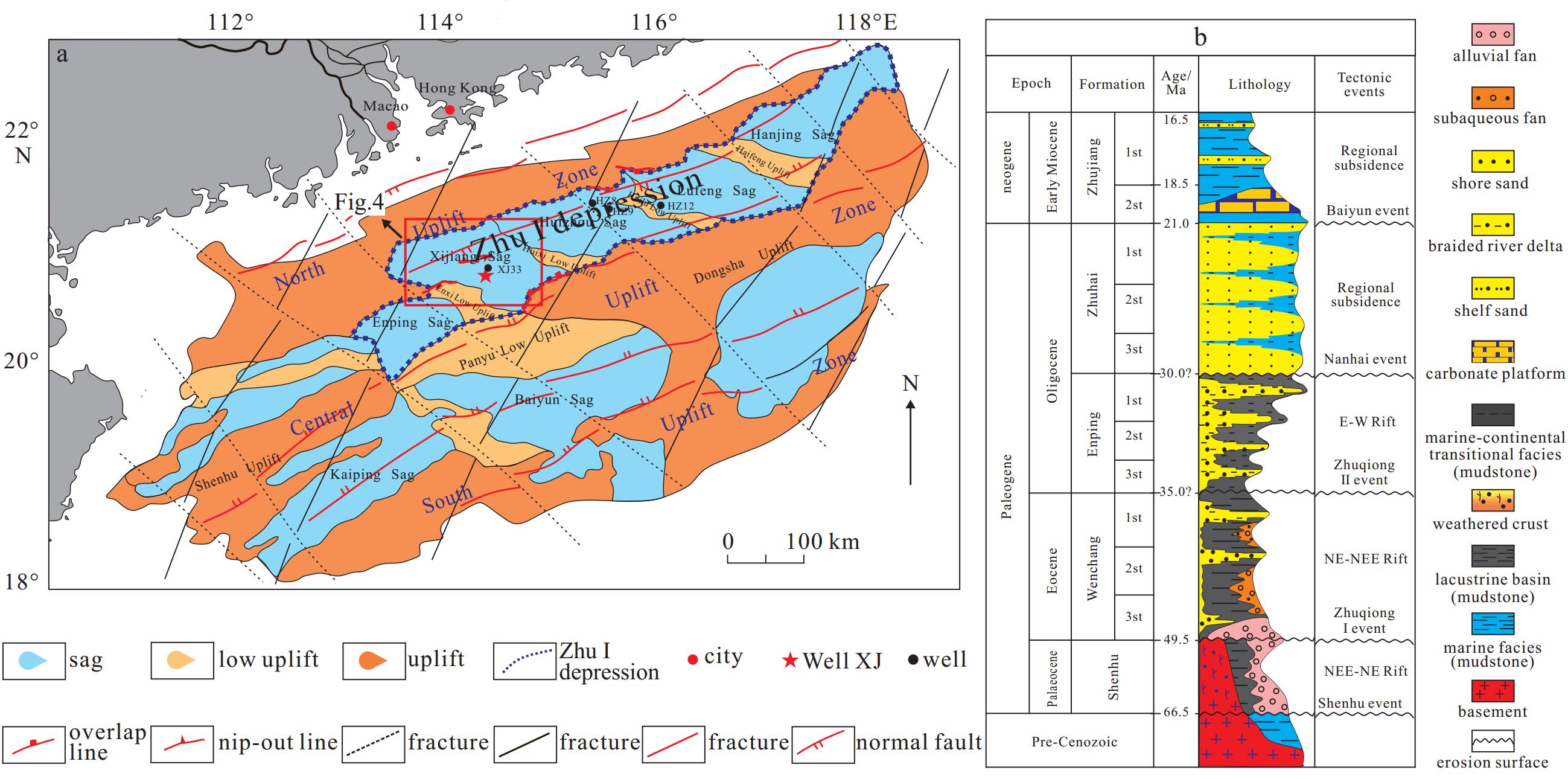Astronomical influence of the development of Paleogene thin coal seam groups in offshore Lacustrine basins: A case study of the Zhu Ⅰ Depression’s Enping Formation located in the northern South China Sea
-
Abstract: The development of the Paleogene coal seams in China’s offshore basin areas generally had the characteristics of coal measures with large thicknesses, large numbers of coal seams, thin single coal seams, poor stability, scattered vertical distribution, and a wide distribution range. This study selected the Enping Formation of the Zhu Ⅰ Depression in the northern section of the South China Sea as an example to determine the macro-control factors of the development of the Paleogene coal seam groups. An analysis was carried out on the influencing effects and patterns of the astronomical cycles related to the development of the thin coal seam groups in the region. A floating astronomical time scale of the Enping Formation was established, and the sedimentary time limit of the Enping Formation was determined to be approximately 6.15 Ma±. In addition, the cyclostratigraphy analysis results of the natural gamma-ray data of Well XJ in the Enping Formation of the Xijiang Sag revealed that the development of the thin coal seams had probably been affected by short eccentricity and precession factors. The formation process of coal seams was determined to have been affected by high seasonal contrast, precipitation, and insolation. During the periods with high values of short eccentricity, the seasonal contrasts tended to be high. During those periods, fluctuations in the precession controls resulted in periodic volume changes in precipitation and insolation of the region, resulting in the development of thin coal seams. It was also found that the periods with low precession were the most conducive to coal seam development. On that basis, combined with such factors as sedimentary environmental conditions conducive to the development of thin coal seam groups, this study established a theoretical model of the comprehensive influences of short eccentricity and precession on the development and distribution of Paleogene thin coal seam groups in offshore lacustrine basins. The patterns of the Paleogene astronomical periods and paleoclimate evolution, along with the control factors which impacted the development of thin coal seam groups in offshore lacustrine basins, were revealed.
-
Figure 1. Geographical location, tectonic units and comprehensive column of the study area. a. The tectonic units of PRMB and Zhu Ⅰ Depression are located in PRMB, showing the location of wells (refer to Wang et al., 2017, modified). b. Comprehensive histogram of PRMB tectonic evolution (Jiang et al., 2009; Zhang et al., 2020a; Wei et al., 2020).
Figure 4. Sedimentary facies distribution characteristics of Enping Formation in Xijiang Sag, Zhu Ⅰ Depression. a. Sedimentary facies distribution of the lower part of Enping Formation (Part B). b. Sedimentary facies distribution of the upper part of Enping Formation (Part A) (see Fig.1).
Figure 5. The lithology, GR curve, evolutionary spectral analysis results, sedimentation rate curves and stratigraphic segmentation of Enping Formation in Well XJ. a. Sequence division and segmentation. b. Lithology and GR curve. c. Evolutionary spectral analysis results with a 100-m sliding window. d. Sedimentation rate curves obtained by eCOCO analysis and eTimeOpt analysis.
Figure 7. Optimal sedimentation rates in Part A and B of Enping Formation by COCO analysis. a. The correlation coefficient in Part A is higher at 15.2 cm/ka. b. Part A null hypothesis confidence, less than 0.001 at 15.2cm/ka. c. The number of astronomical parameters contributed by Part A in the test of sedimentation rate is 7 at 15.2 cm/ka. d. The correlation coefficient of Part B is higher value at 7.9 cm/ka. e. Part B null hypothesis confidence, less than 0.01 at 7.9 cm/ka. f. The number of astronomical parameters contributed by Part B in the test of sedimentation rate is 7 at 7.9 cm/ka.
Figure 8. TimeOpt analysis in Part A of Enping Formation. a. Combined envelope and spectral power fit (
${\mathrm{r}}^{2}_{{\mathrm{opt}}} $ ) at each evaluated sedimentation rate and the summary of 2 000 Monte Carlo simulations, p-value = 0.019 5. b. The squared Pearson correlation coefficient (${\mathrm{r}}^{2}_{{\mathrm{envelope}}} $ ; red) and spectral power fitting correlation coefficient (${\mathrm{r}}^{2}_{{\mathrm{power}}} $ ; gray). c. Cross plot of the data amplitude envelope and the TimeOpt-reconstructed eccentricity model in panel “d”; dashed red line is the 1:1 line. d. Comparison of data amplitude envelope (red) and TimeOpt reconstructed eccentricity model (black). e. Comparison of band-pass precession signal (blue) with data amplitude envelope (red). f. Periodogram of the data. The red dotted line indicates the target period of eccentricity and precession.Figure 10. TimeOpt analysis in Part B of Enping Formation. a. Combined envelope and spectral power fit (r2opt) at each evaluated sedimentation rate and the summary of 2 000 Monte Carlo simulations, p-value = 0.001. b. The squared Pearson correlation coefficient (r2envelope; red) and spectral power fitting correlation coefficient (r2power; gray). c. Cross plot of the data amplitude envelope and the TimeOpt-reconstructed eccentricity model in panel “d”; dashed red line is the 1:1 line. d. Comparison of data amplitude envelope (red) and TimeOpt reconstructed eccentricity model (black). e. Comparison of band-pass precession signal (blue) with data amplitude envelope (red). f. Periodogram of the data. The red dotted line indicates the target period of eccentricity and precession.
Figure 11. The filtering results of long eccentricity (blue) and short eccentricity (red) in Part A and Part B of Enping Formation. a. Filtering results, detrended GR data in the depth domain, and the GR time series of the GR depth record converted to the time domain of Part A. b. Filtering results, detrended GR data in the depth domain, and the GR time series of the GR depth record converted to the time domain of Part B.
Figure 12. The relationship between lithology and eccentricity and precession filter curves in Part A of Enping Formation. a. Comparison of GR curve and lithology with long eccentricity (blue), short eccentricity (red), and precession (yellow) filter curves in the depth domain. b. Comparison of continuous multi-layer thin coal seams and filter curves in depth domain in 4060-4 080 m. c. Comparison ofcontinuous multi-layer thin coal and filter curves in depth domain in 4 100−4 120 m.
Figure 13. The relationship between lithology and eccentricity and precession filter curves of Enping Formation Part B. a. Comparison of GR curve and lithology with long eccentricity (blue), short eccentricity (red), and precession (yellow) filter curves in the depth domain. b. Comparison of 4440−4470 m continuous multi-layer thin coal and filter curves in depth domain. c. Comparison of 4540−4560 m continuous multi-layer thin coal and filter curves in depth domain.
-
Abels H A, Aziz H A, Krijgsman W, et al. 2010. Long-period eccentricity control on sedimentary sequences in the continental Madrid Basin (middle Miocene, Spain). Earth & Planetary Science Letters, 289(1–2): 220–231 Ao H, Dupont-Nivet G, Rohling E J, et al. 2020. Orbital climate variability on the northeastern Tibetan Plateau across the Eocene-Oligocene transition. Nature Communications, 11(1): 5249, doi: 10.1038/s41467-020-18824-8 Berger A, Loutre M F, Laskar J. 1992. Stability of the astronomical frequencies over the Earth’s history for paleoclimate studies. Science, 255(5044): 560–566, doi: 10.1126/science.255.5044.560 Boulila S, Galbrun B, Miller K G, et al. 2011. On the origin of Cenozoic and Mesozoic “third order” eustatic sequences. Earth-science reviews, 109(3–4): 94–112, doi: 10.1016/j.earscirev.2011.09.003 Bosmans J H C, Erb M P, Dolan A M, et al. 2018. Response of the Asian summer monsoons to idealized precession and obliquity forcing in a set of GCMs. Quaternary Science Reviews, 188: 121–135, doi: 10.1016/j.quascirev.2018.03.025 Boucot A J, Xu C, Scotese C R, et al. 2013. Phanerozoic paleoclimate: An atlas of lithologic indicators of climate. In: SEPM Concepts in Sedimentology and Paleontology. SEPM Society for Sedimentary Geology Cao Qinming. 2021. Formation mechanism of middle-deep sandstone reservoir of Eocene in Zhu Ⅰ Depression, Pearl River Mouth Basin (in Chinese)[dissertation]. Chengdu: Chengdu University of Technology Cheng Yuan. 2018. Study on semi-quantitative prediction model on sensitive parameters of “source to sink” system in continental basin (in Chinese)[dissertation]. Wuhan: China University of Geosciences Cheng Shixiu, Li Sanzhong, Suo Yanhui, et al. 2012. Cenozoic tectonics and dynamics of basin groups of the Northern South China Sea. Marine Geology & Quaternary Geology (in Chinese), 32(6): 79–93 Fu Chao, Li Shengli, Li Shunli, et al. 2021. Spatial and temporal variability of sediment infilling and episodic rifting in the North Pearl River Mouth Basin, South China Sea. Journal of Asian Earth Sciences, 211: 104702, doi: 10.1016/j.jseaes.2021.104702 Gong Yiming, Xu Ran, Tang Zhongdao, et al. 2005. The Upper Devonian orbital cyclostratigraphy and numerical dating conodont zones from Guangxi, South China. Science in China Series D:Earth Sciences, 48(1): 32–41, doi: 10.1360/03yd0025 Guo Pengfei. 2015. Formation mechanism of high-quality source rock and its contribution to hydrocarbon accumulation in Zhuyi Depression, Pearl River Mouth Basin (in Chinese)[dissertation]. Wuhan: China University of Geosciences Guo Qiaozhen, Chen Feng, Yang Xianghua, et al. 2013. Shallow braided deltaic system in Enping formation of Huizhou Depression, Pearl River Mouth. Marine Geology & Quaternary Geology (in Chinese), 33(1): 25–32 Galeotti S, Deconto R, Naish T, et al. 2016. Antarctic Ice Sheet variability across the Eocene-Oligocene boundary climate transition. Science, 352(6281): 76–80, doi: 10.1126/science.aab0669 Hinnov L A. 2013. Cyclostratigraphy and its revolutionizing applications in the earth and planetary sciences. Geological Society of America Bulletin, 125(11–12): 1703–1734, doi: 10.1130/B30934.1 Huang Lüsheng. 1999. Tertiary biostratigraphic framework of Pearl River Mouth Basin. China Offshore Oil and Gas (Geology) (in Chinese), 13(6): 406–415 Huang Lüsheng, Zhong Bizhen. 1998. New materials of the calcareous nannofssil in the middle Eocene Wenchang Formation from the Pearl River Mouth Basin. China Offshore Oil and Gas (Geology) (in Chinese), 12(1): 31–35 Husinec A, Read J F. 2018. Cyclostratigraphic and δ13C record of the Lower Cretaceous Adriatic platform, Croatia: Assessment of Milankovitch-forcing. Sedimentary Geology, 373: 11–31, doi: 10.1016/j.sedgeo.2018.05.010 Jiang Hua, Wang Hua, Li Junliang, et al. 2009. Research on hydrocarbon pooling and distribution patterns in the Zhu-3 Depression, the Pearl River Mouth Basin. Oil & Gas Geology (in Chinese), 30(3): 275–281,286 Kashiwaya K, Ochiai S, Sakai H, et al. 2001. Orbit-related long-term climate cycles revealed in a 12-Myr continental record from Lake Baikal. Nature, 410(6824): 71–74, doi: 10.1038/35065057 Kodama K P, Hinnov L A. 2014. Rock Magnetic Cyclostratigraphy. New Jersey: Wiley-Blackwell Laskar J, Robutel P, Joutel F, et al. 2004. A long-term numerical solution for the insolation quantities of the earth. Astronomy and Astrophysics, 428(1): 261–285, doi: 10.1051/0004-6361:2004 1335 Lei Zuoqi. 1993. Discussion on the age assignment of Enping Formation in the Pearl River Mouth basin. Journal of Stratigraphy (in Chinese), 17(2): 108–114 Li Shaojie. 2015. Study on the formation modes of coal-measure source rocks in northern basins of South China Sea (in Chinese)[dissertation]. Wuhan: China University of Geosciences Li Mingsong, Hinnov L, Kump L. 2019. Acycle: Time-series analysis software for paleoclimate research and education. Computers & Geosciences, 127: 12–22 Li Bangyong, Huang Chuanyan, Zhang Hongwei, et al. 2016a. Provenance system characters of fault-depressed transforming period: Insights from the third member of Dongying formation in Baxian Sag. Geological Science and Technology Information (in Chinese), 35(3): 56–64 Li Y X, Jiao W J, Liu Z H, et al. 2016b. Terrestrial responses of low-latitude Asia to the Eocene-Oligocene climate transition revealed by integrated chronostratigraphy. Climate of the Past, 12(2): 255–272, doi: 10.5194/cp-12-255-2016 Li Mingsong, Kump L R, Hinnov L A, et al. 2018. Tracking variable sedimentation rates and astronomical forcing in Phanerozoic paleoclimate proxy series with evolutionary correlation coefficients and hypothesis testing. Earth and Planetary Science Letters, 501: 165–179, doi: 10.1016/j.jpgl.2018.08.041 Li Zengxue, Liu Ying, Li Xiaojing, et al. 2022. The control of Paleogene peat swamp destruction and reconstruction on the formation of coal-type source material in the Qiongdongnan Basin. Oil & Gas Geology (in Chinese), 43(6): 1309–1320 Li Zhenxiong, Ma Junrong. 1992. Polynological assemblages of Enping formation in the Pearl River Mouth. Acta Petrolei Sinica (in Chinese), 13(2): 258–267 Li Pinglu, Rao Chuntao. 1994. Tectonic characteristics and evolution history of the Pearl river mouth basin. Tectonophysics, 235(1–2): 13–25, doi: 10.1016/0040-1951(94)90014-0 Li Sanzhong, Suo Yanhui, Liu Xin, et al. 2012a. Basin dynamics and basin groups of the South China Sea. Marine Geology & Quaternary Geology (in Chinese), 32(6): 55–78 Li Zengxue, Zhang Gongcheng, Li Ying, et al. 2012b. The Paleogene coal-bearing basin and coal-measures distribution of China sea area. Earth Science Frontiers (in Chinese), 19(4): 314–326 Liu Wei, Wu Huaichun, Hinnov L A, et al. 2020. An 11 million-year-long record of astronomically forced fluvial-alluvial deposition and paleoclimate change in the Early Cretaceous Songliao synrift basin, China. Palaeogeography, Palaeoclimatology, Palaeoecology, 541: 109555 Meyers S R. 2015. The evaluation of eccentricity-related amplitude modulation and bundling in paleoclimate data: An inverse approach for astrochronologic testing and time scale optimization. Paleoceanography, 30(12): 1625–1640, doi: 10.1002/2015PA002850 Meyers S R. 2019. Cyclostratigraphy and the problem of astrochronologic testing. Earth-Science Reviews, 190: 190–223, doi: 10.1016/j.earscirev.2018.11.015 Morley C K. 2016. Major unconformities/termination of extension events and associated surfaces in the South China Seas: Review and implications for tectonic development. Journal of Asian Earth Sciences, 120: 62–86, doi: 10.1016/j.jseaes.2016.01.013 Noorbergen L J, Abels H A, Hilgen F J, et al. 2018. Conceptual models for short-eccentricity-scale climate control on peat formation in a lower Palaeocene fluvial system, north-eastern Montana (USA). Sedimentology, 65(3): 775–808, doi: 10.1111/sed.12405 Olsen P E, Kent D V. 1996. Milankovitch climate forcing in the tropics of Pangaea during the Late Triassic. Palaeogeography, Palaeoclimatology, Palaeoecology, 122(1–4): 1–26 Peng Guangrong, Chen Weitao, Jia Peimeng, et al. 2023a. Middle-late Eocene climate in the Pearl River Mouth Basin: Evidence from a palynological and geological element record in the Xijiang main subsag. Minerals, 13(3): 374, doi: 10.3390/min13030374 Peng Guangrong, Long Zulie, Shi Yuling, et al. 2022. Discussion on integrated geological and geophysical identification method for spatial distribution of favorable source rocks in depression with lack of drilling data: a case study of Enping 17 Sag, Zhu Ⅰ Depression, Pearl River Mouth Basin. Petroleum Geology & Experiment (in Chinese), 44(6): 1116–1122 Peng Guangrong, Zhang Lili, Xu Xinming, et al. 2023b. Core complex and detachment structure in the Kaiping Sag, Pearl River Mouth Basin and a discussion on the dynamics. Earth Science (in Chinese), 1–18 Ren Jianye, Lei Chao. 2011. Tectonic stratigraphic framework of Yinggehai-Qiongdongnan Basins and its implication for tectonic province division in South China Sea. Chinese Journal of Geophysics (in Chinese), 54(12): 3303–3314 Rollins M S, Cohen A D, Durig J R. 1993. Effects of fires on the chemical and petrographic composition of peat in the Snuggedy Swamp, South Carolina. International Journal of Coal Geology, 22(2): 101–117, doi: 10.1016/0166-5162(93)90020-B Shao Longyi, Dang Xingyu, Gao Xiangyu, et al. 2022a. Genetic mechanism of thick coal seams: astronomical-forcing superimposed multi-staged swamp model. Coal Science and Technology (in Chinese), 50(1): 186–195 Shao Lei, Meng Anhui, Li Qianyu, et al. 2017. Detrital zircon ages and elemental characteristics of the Eocene sequence in IODP Hole U1435A: Implications for rifting and environmental changes before the opening of the South China Sea. Marine Geology, 394: 39–51, doi: 10.1016/j.margeo.2017.08.002 Shao Longyi, Wen He, Gao Xiangyu, et al. 2022b. Identification of milankovitch cycles and calculation of net primary productivity of paleo-peatlands using geophysical logs of coal seams. Acta Geologica Sinica-English Edition, 96(6): 1830–1841, doi: 10.1111/1755-6724.14966 Shao Longyi, Xu Xiaotao, Wang Shuai, et al. 2021. Research progress of palaeogeography and palaeoenvironmental evolution of coal-bearing series in China. Journal of Palaeogeography (in Chinese), 23(1): 19–38 Shen Yulin, Qin Yong, Guo Yinghai, et al. 2016. Development characteristics of coal-measure source rocks divided on the basis of Milankovich coal accumulation cycle in Pinghu Formation, Xihu sag. Acta Petrolei Sinica (in Chinese), 37(6): 706–714 Tang Xiaoyin, Yang Shuchun, Hu Shengbiao. 2020. Provenance of the Paleogene sediments in the Pearl River Mouth Basin, northern South China Sea: Insights from zircon U-Pb and fission track double dating. Journal of Asian Earth Sciences, 200: 104494, doi: 10.1016/j.jseaes.2020.104494 Tardif D, Toumoulin A, Fluteau F, et al. 2021. Orbital variations as a major driver of climate and biome distribution during the greenhouse to icehouse transition. Science Advances, 7(43): eabh2819, doi: 10.1126/sciadv.abh2819 Thomson D J. 1982. Spectrum estimation and harmonic analysis. Proceedings of the IEEE, 70(9): 1055–1096, doi: 10.1109/PROC.1982.12433 Tyszka J. 2009. Foraminiferal response to seasonality modulated by orbital cycles in the Cretaceous mid-latitudes: The Albian record from the Lower Saxony Basin. Palaeogeography, Palaeoclimatology, Palaeoecology, 276(1–4): 148–159 Valero L, Garcés M, Cabrera L, et al. 2014. 20 Myr of eccentricity paced lacustrine cycles in the Cenozoic Ebro Basin. Earth & Planetary Science Letters, 408(1): 183–193 Valero L, Cabrera L, Sáez A, et al. 2016. Long-period astronomically-forced terrestrial carbon sinks. Earth and Planetary Science Letters, 444: 131–138, doi: 10.1016/j.jpgl.2016.03.038 Van Vugt N, de Bruijn H, van Kolfschoten M, et al. 2000. Magneto- and cyclostratigraphy and mammal-fauna's of the Pleistocene lacustrine Megalopolis Basin, Peloponnesos, Greece. Geologica Ultraiectina, 189: 69–92 Van Vugt N, Langereis C G, Hilgen F J. 2001. Orbital forcing in Pliocene-Pleistocene Mediterranean lacustrine deposits: dominant expression of eccentricity versus precession. Palaeogeography, Palaeoclimatology, Palaeoecology, 172(3–4): 193–205 Vázquez A, Utrilla R, Zamarreño I, et al. 2000. Precession-related sapropelites of the Messinian Sorbas Basin (South Spain): paleoenvironmental significance. Palaeogeography, Palaeoclimatology, Palaeoecology, 158(3–4): 353–370 Wang Pengcheng, Li Sanzhong, Guo Lingli, et al. 2017. Opening of the South China Sea (SCS): ajoint effect of dextral strike-slip pull-apart and proto-SCS slab pull. Earth Science Frontiers (in Chinese), 24(4): 294–319 Wang Dongdong, Li Zengxue, Zhang Gongcheng, et al. 2011. Base level cycles division and switch mechanism of oligocene epoch Yacheng formation in Qiongdongnan basin. Journal of China University of Mining & Technology (in Chinese), 40(4): 576–583 Wang Dongdong, Zhang Gongcheng, Li Zengxue, et al. 2021. The development characteristics and distribution predictions of the Paleogene coal-measure source rock in the Qiongdongnan Basin, Northern South China Sea. Acta Geologica Sinica (English Edition), 95(1): 105–120, doi: 10.1111/1755-6724.14625 Wei Xiaosong, Yan Detian, Luo Pan, et al. 2020. Astronomically forced climate cooling across the Eocene–Oligocene transition in the Pearl River Mouth Basin, northern South China Sea. Palaeogeography, Palaeoclimatology, Palaeoecology, 558: 109945 Weedon G P. 2003. Time-Series Analysis and Cyclostratigraphy: Constructing time series in cyclostratigraphy. Cauces Cuadernos Del Consejo Económico Y Social, 134(s1-2): 77–78. Wu Guoxuan, Qin Jungan, Mao Shaozhi. 2003. Palynological records of the Xiocene series of the deep sea facies in the South China Sea. Chinese Science Bulletin (in Chinese), 48(17): 1868–1871, doi: 10.1360/csb2003-48-17-1868 Wu Yuxiang, Shu Yu, Ding Lin, et al. 2021. Prediction of high quality source rocks based on sequence stratigraphic framework of Wenchang formation, Panyu 4 depression, the Pearl River Mouth Basin. Marine Geology Frontiers (in Chinese), 37(3): 41–49 Wu Huaichun, Zhang Shihong, Feng Qinglai, et al. 2011. Theoretical basis, research advancement and prospects of cyclostratigraphy. Earth Science (in Chinese), 36(3): 409–428 Wu Huaichun, Zhang Shihong, Jiang Ganqing, et al. 2013. Astrochronology of the Early Turonian–Early Campanian terrestrial succession in the Songliao Basin, northeastern China and its implication for long-period behavior of the Solar System. Palaeogeography, Palaeoclimatology, Palaeoecology, 385: 55–70 Xu Ke, Kemp D B, Ren Jianye, et al. 2023. Astronomically forced climate variability across the Eocene–Oligocene transition from a low latitude terrestrial record (Lühe Basin, South China). GSA Bulletin, 135(9-10): 2678–2690 Xia Wenyue. 2022. Cyclostratigraphy on the Eocene Wenchang Formation in the Pearl River Mouth Basin (in Chinese)[dissertation]. Beijing: China University of Geosciences. Yin Lusheng. 2022. Coal-forming Sedimentary Environment and Coal Accumulation Law of the Paleogene Enping Formation in the Zhu Ⅰ Depression (in Chinese)[dissertation]. Shandong University of Science and Technology. Zhang Gongcheng. 2010. Tectonic evolution of deepwater area of northern continental margin in South China Sea. Acta Petrolei Sinica (in Chinese), 31(4): 528–533,541 Zhang Gongcheng, Chen Ying, Li Zengxue, et al. 2022. Theory on genesis of coaliferous petroleum in the China Sea. Oil & Gas Geology (in Chinese), 43(3): 553–565 Zhang Gongcheng, Jia Qingjun, Wang Wanyin, et al. 2018. On tectonic framework and evolution of the South China Sea. Chinese Journal of Geophysics (in Chinese), 61(10): 4194–4215 Zhang Gongcheng, Li Zengxue, Wang Dongdong, et al. 2020c. Characteristics of coal geology in South China Sea. Journal of China Coal Society (in Chinese), 45(11): 3864–3878 Zhang Gongcheng, Mi Lijun, Wu Shiguo, et al. 2007. Deepwater area-the new prospecting targets of northern continental margin of South China Sea. Acta Petrolei Sinica (in Chinese), 28(2): 15–21 Zhang Gongcheng, Qu Hongjun, Liu Shixiang, et al. 2015b. Tectonic cycle of marginal sea controlled the hydrocarbon accumulation in deep-water areas of South China Sea. Acta Petrolei Sinica (in Chinese), 36(5): 533–545 Zhang Chunliang, Shen Yulin, Qin Yong, et al. 2016a. Development regularities of the coal-measure source rock in Ya-3 member of Yacheng formation, well Y1, in Yanan depression within Qiongdongnan Basin. Acta Sedimentologica Sinica (in Chinese), 34(5): 1003–1010 Zhang Lili, Shu Liangfeng, Feng Xuan, et al. 2020a. Further discussion on the age assignment of Enping Formation in the Pearl River Mouth basin. China Offshore Oil and Gas (in Chinese), 32(5): 9–18 Zhang Zhihui, Wang Chengshan, Lü Dawei, et al. 2020b. Precession-scale climate forcing of peatland wildfires during the early middle Jurassic greenhouse period. Global and Planetary Change, 184: 103051, doi: 10.1016/j.gloplacha.2019.103051 Zhang Gongcheng, Wang Qi, Miao Shunde, et al. 2014b. The duality distribution pattern of marine-continental transitional hydrocarbon source rocks: A case study from Baiyun Sag in Pearl River Mouth Basin, China offshore. Natural Gas Geoscience (in Chinese), 25(9): 1299–1308 Zhang Gongcheng, Wang Pujun, Wu Jingfu, et al. 2015a. Tectonic cycle of marginal oceanic basin: a new evolution model of the South China Sea. Earth Science Frontiers (in Chinese), 22(3): 27–37 Zhang Gongcheng, Xie Xiaojun, Wang Wanyin, et al. 2013. Tectonic types of petroliferous basins and its exploration potential in the South China Sea. Acta Petrolei Sinica (in Chinese), 34(4): 611–627 Zhang Gongcheng, Yang Haizhang, Chen Ying, et al. 2014a. The Baiyun Sag: a giant rich gas-generation sag in the deepwater area of the Pearl River Mouth Basin. Natural Gas Industry (in Chinese), 34(11): 11–25 Zhang Gongcheng, Zeng Qingbo, Su Long, et al. 2016b. Accumulation mechanism of LS17–2 deep water giant gas field in Qiongdongnan Basin. Acta Petrolei Sinica (in Chinese), 37(S1): 34–46 Zhang Gongcheng, Zhu Weilin, Mi Lijun, et al. 2010. The theory of hydrocarbon Genernation controlled by source rock and heat from circle distribution of outside-oil fields and inside-gas fields in South China Sea. Acta Sedimentologica Sinica (in Chinese), 28(5): 987–1005 Zhao Ke, Du Xuebin, Jia Jixin, et al. 2021. Effects of sea-level variation and sedimentary noise variation on the development of biogenic reefs since the Pliocene among the Xisha Islands, South China Sea. Geological Society of America Bulletin, 134(7-8): 1781–1792 Zhao Ke, Du Xuebin, Jia Jixin, et al. 2022. Orbitally controls of climate recorded in a series of thin-multiple-layers coal seams in marine–continent transition environment during late Eocene. Palaeogeography, Palaeoclimatology, Palaeoecology, 606: 111233 Zhou Fengjuan, Ding Lin, Ma Yongkun, et al. 2020. Detrital zircon U-Pb age characteristics of Wenchang Formation in Lufeng 13 eastern sag and its significance for provenance tracing. China Offshore Oil and Gas (in Chinese), 32(4): 46–55 Zhu Mingyu, Shao Longyi, Sun Bin, et al. 2022. Sequence paleogeography and coal accumulation model in the fluvio-lacustrine rift basin: The Lower Cretaceous of the Huhehu Sag of Hailar Basin, Inner Mongolia (NE China). Marine and Petroleum Geology, 145: 105879, doi: 10.1016/j.marpetgeo.2022.105879 -





 下载:
下载:
